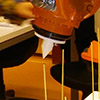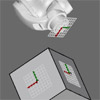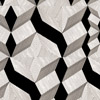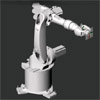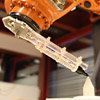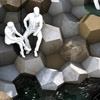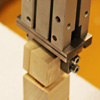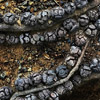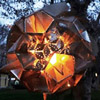Today in the Digital Fabrication course, we examined digital-physical translations utilizing the robots add-on for Grasshopper. Students learn how to get coordinate data from a physical environment, use it in the digital model and apply it to a robot motion. We aimed to dig chopsticks into an EPS block by using a special wooden tool called “Chopstick Digger”. In the first hour of the class, we attached the “pointer” tool, […]
October 2018
In the Digital Fabrication course, we are in the middle of a sea, full of technical details, and students need motivation. This is why I felt I should do something simple and educational but funny at the same time; a “kissing the cube” exercise. The planned exercise was about programming the robot to touch every facet of a cube without colliding with it. Of course, we couldn’t manage to kiss […]
One of the new assignments of our Computation-based Basic Design studio is called “Self-Organizing Patterns”. Although I’m not very sure about their self-organization potential, there are several good examples of systematic pattern-making. In the third week of their design education, some of the students proved themselves very well in analyzing and re-configuring natural structures in 2D abstract compositions. Selina Şişik Kardelen Kurt Sude Aydın
Today, we started learning Robots add-on for Grasshopper. The first two codes we experimented with were similar to the first week’s jogging exercises. In the first one called “axial jogging”, we had 6 number sliders to control the angles of the axes. Every number slider generates values between -Pi and +Pi. These numbers are joined into a text by adding a comma in between. Then, Create program and Simulate Program […]
On the second day of the Digital Fabrication course, we tried to understand what is a “tool” and how to draw/ produce/ attach/calibrate a simple penholder tool for our robot. This study will hopefully make students aware of the effects of these procedures in robotic design and fabrication. The tool we used here is based on this Rhino drawing laser-cut from a waste plexiglass sheet. The flange of our robot has a diameter […]
This is a competition entry on the innovative uses of natural stone. Urban Polyhedra aims to organize the natural stone usage, especially on the shores. In the current implementation of this system, random blocks are placed to prevent landslides on the urban coastal areas, but restrict the interaction of the citizens with the shore, and destroy the spaces for sea creatures, and vegetation. Thus, this random placement makes it difficult […]
In this semester, I started a new elective course at İstanbul Bilgi University Faculty of Architecture. Second, third and fourth-year architecture, interior design, and industrial design students attend the course titled “Digital Fabrication”. I am very excited to study the basics of robotic fabrication together with the students. I’ll try to report the content of the lectures and the robot exercises on designcoding.net. Below is the general brief of the […]
This is the first assignment named Design in the Forest of the new “Computation-based Basic Design” curriculum at İstanbul Bilgi University Faculty of Architecture. We are excited to see the students merging their conceptions of natural structures with the skills they start gaining in geometry classes. In the next assignments, we expect to generate patterns and structures by the abstraction of these initial sketches. Humay Aliyeva Sude Akay Here is an […]
In the first-year Computation Based Basic Design studio at İstanbul Bilgi University, the aim is to help students understand that design, due to its prevalent relational nature incorporates different forms of reasoning as indispensable constituents within the creative process (Yalınay Çinici, 2013). The studio integrates the 1:1 scale construction via computational thinking which consists of geometric relations, material computation/performance, and CAD/CAM technologies. The aim of the studio is to develop an awareness of immediate or far surroundings […]

